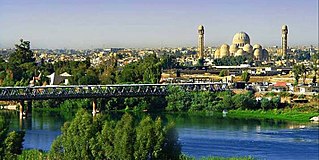
Nineveh or Ninawa Governorate is a governorate in northern Iraq. It has an area of 37,323 km2 (14,410 sq mi) and an estimated population of 2,453,000 people as of 2003. Its largest city and provincial capital is Mosul, which lies across the Tigris river from the ruins of ancient Nineveh. Before 1976, it was called Mosul Province and included the present-day Dohuk Governorate. The second largest city is Tal Afar, which has an almost exclusively Turkmen population.
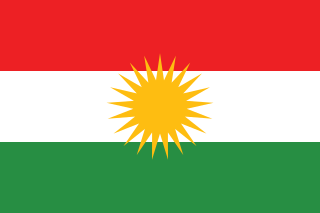
The Peshmerga are the armed forces of Iraqi Kurdistan, an autonomous region in northern Iraq. According to the Constitution of Iraq, regional governments are responsible for "the establishment and organization of the internal security forces for the region such as police, security forces, and guards of the region". Other Kurdish defence and security agencies include the Zêrevanî (gendarmerie), Asayish, and the Parastin û Zanyarî. The Peshmerga's history dates back to the 18th century, when they began as a tribal paramilitary border guard under the Ottoman Turks and the Safavid Iranians. By the 19th century, they had evolved into a disciplined and well-trained guerrilla force.
The 2008 Nineveh campaign was a series of offensives and counter-attacks between insurgent and Coalition forces for control of the Nineveh Governorate in northern Iraq in early-to-mid-2008. Some fighting also occurred in the neighboring Kirkuk Governorate.

The 1st Division (IFF) is a motorized infantry division of the Iraqi Army headquartered in Camp Fallujah.

The 2nd Division was a formation of the Iraqi Army. It was theoretically headquartered at Mosul, but was driven out of that city by IS. No reliable reports of its continued existence have surfaced since June–July 2014. Previously, the 2nd Division was one of the most experienced formations in the Iraqi Army.
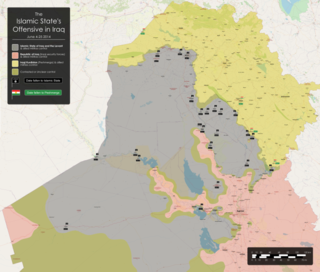
The Northern Iraq offensive began on 4 June 2014, when the Islamic State of Iraq and Levant, assisted by various insurgent groups in the region, began a major offensive from its territory in Syria into Iraq against Iraqi and Kurdish forces, following earlier clashes that had begun in December 2013 involving guerillas.
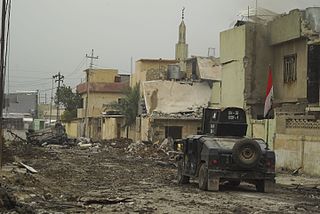
The War in Iraq (2013–2017) was an armed conflict between Iraq and its allies and the Islamic State. Following December 2013, the insurgency escalated into full-scale guerrilla warfare following clashes in the cities of Ramadi and Fallujah in parts of western Iraq, and culminated in the Islamic State offensive into Iraq in June 2014, which lead to the capture of the cities of Mosul, Tikrit and other cities in western and northern Iraq by the Islamic State. Between 4–9 June 2014, the city of Mosul was attacked and later fell; following this, Prime Minister Nouri al-Maliki called for a national state of emergency on 10 June. However, despite the security crisis, Iraq's parliament did not allow Maliki to declare a state of emergency; many legislators boycotted the session because they opposed expanding the prime minister's powers. Ali Ghaidan, a former military commander in Mosul, accused al-Maliki of being the one who issued the order to withdraw from the city of Mosul. At its height, ISIL held 56,000 square kilometers of Iraqi territory, containing 4.5 million citizens.
Between 1 and 15 August 2014, the Islamic State of Iraq and the Levant (ISIL) expanded territory in northern Iraq under their control. In the region north and west from Mosul, the Islamic State conquered Zumar, Sinjar, Wana, Mosul Dam, Qaraqosh, Tel Keppe, Batnaya and Kocho, and in the region south and east of Mosul the towns Bakhdida, Karamlish, Bartella and Makhmour
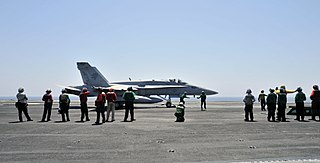
On 15 June 2014 U.S. President Barack Obama ordered United States forces to be dispatched in response to the Northern Iraq offensive of the Islamic State (IS), as part of Operation Inherent Resolve. At the invitation of the Iraqi government, American troops went to assess Iraqi forces and the threat posed by ISIL.
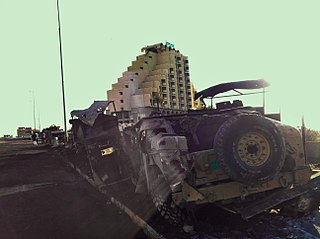
The fall of Mosul in Iraq occurred between 4 and 10 June 2014, when Islamic State (IS) insurgents, initially led by Abu Abdulrahman al-Bilawi, captured Mosul from the Iraqi Army, led by Lieutenant General Mahdi Al-Gharrawi.

The Timeline of the War in Iraq covers the War in Iraq, a war which erupted that lasted in Iraq from 2013 to 2017, during the first year of armed conflict.

The Mosul offensive (2015) was an offensive launched by Kurdish Peshmerga forces on 21 January 2015, with the objective of severing key ISIL supply routes to Mosul, Iraq, and to recapture neighboring areas around Mosul. The effort was supported by US-led coalition airstrikes. The Iraqi Army was widely expected to launch the planned operation to retake the actual city of Mosul in the Spring of 2015, but the offensive was postponed to October 2016, after Ramadi fell to ISIL in May 2015.
In early 2014, the jihadist group Islamic State of Iraq and the Levant captured extensive territory in Western Iraq in the Anbar campaign, while counter-offensives against it were mounted in Syria. Raqqa in Syria became its headquarters. The Wall Street Journal estimated that eight million people lived under its control in the two countries.
The Nineveh Plains offensive was a battle in which the Islamic State of Iraq and the Levant (ISIL) mounted a multi-front attack against Peshmerga forces in the area north and east of Mosul, in December 2015. The attack—the most significant ISIL military operation in the area in months, was successfully repelled by the Kurdish forces and was followed by a coalition air counter-offensive.

The Shirqat offensive, codenamed Operation Conquest or Operation Fatah, was an offensive against the positions of the Islamic State of Iraq and the Levant (ISIL) in and around the district of Al-Shirqat District to reach the city of Mosul.
The Battle of Hit, code named Operation Desert Lynx by Iraqi forces, was an offensive launched by the Iraqi Government during the Anbar offensive, with the goal of recapturing the town of Hīt and the Hīt District from ISIL. After the Iraqi forces recaptured the city of Ramadi, Hīt and Fallujah were the only cities still under the control of ISIL in the Al Anbar Governorate. Iraqi Forces fully recaptured Hīt and the rest of the Hīt District on 14 April 2016.
This is a timeline of events during the War in Iraq in 2016.
This is the Military intervention against ISIL ground order of battle, which lists the American forces and allies aerial assets that have taken part in the Military intervention against ISIL between June 2014 and the present day.
This is a timeline of events during the Islamic State insurgency in Iraq (2017–present) in 2021.
This is a timeline of events during the Islamic State insurgency in Iraq (2017–present) in 2018.











